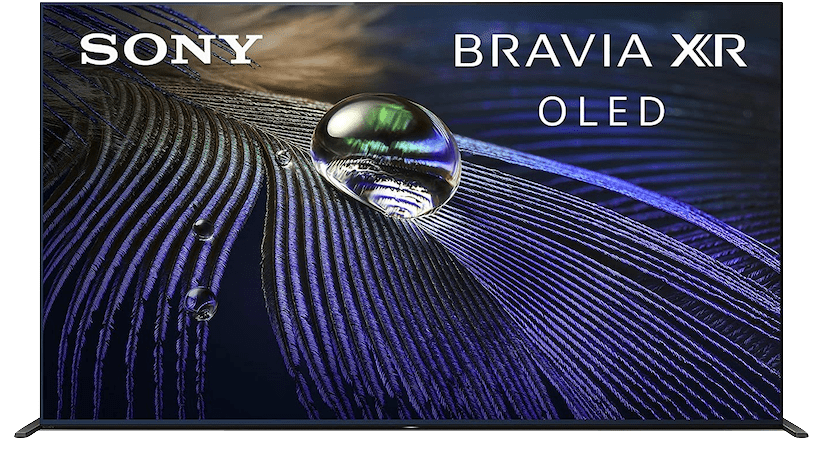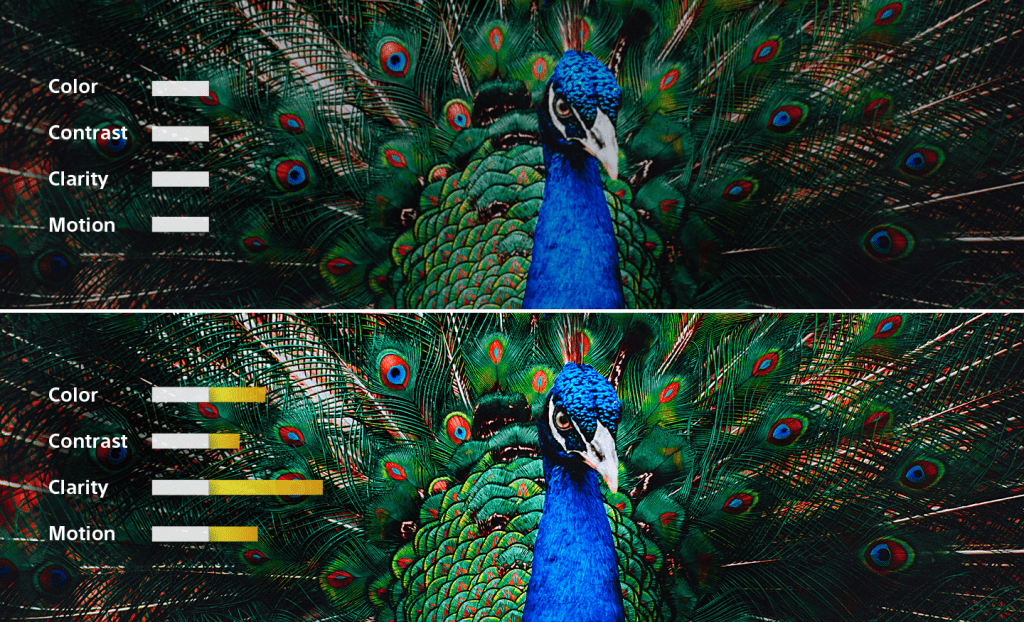Not sure how to start your search for a new TV? The first and most important thing is to choose the right screen type – LED, OLED, or QLED. Each of these types has its own advantages and disadvantages. However, OLED screens are the most common panels on the market. That is why we have decided to compare LG G1 vs Sony A90J, two great OLED TVs!
LG G1 vs Sony A90J – Quick Comparison
Both of these TV brands are known for producing high-quality TVs with many innovative solutions. Being two big players in the TV market, these brands always try to present something new.
The table below shows the specifications of both TVs. As you can see, there are different sizes for each model. Many people don’t know which TV size they should choose. This depends on the size of your room, the number of people who will watch the TV, etc.
However, if you want to find a suitable TV, read the entire article since we go through each of these aspects step-by-step.
| Features | LG G1 | Sony A90J |
|---|---|---|
| Screen sizes | 55, 65, 77 inches | 55, 65, 83 inches |
| Screen Panel | OLED (Evo) | OLED |
| Processor | α9 Gen4 AI Processor 4K | Cognitive Processor XR |
| Operating system | webOS 6.0 Smart TV | Google TV |
| Refresh rate | 120 Hz | 120 Hz |
| Variable refresh rate | Yes | No |
| Resolution | 3840×2160 | 3840×2160 |
| Contrast ratio | infinite :1 | infinite :1 |
| HDMI ports | 4 (HDMI 2.1) | 4 (2x HDMI 2.1, 2x HDMI 2.0) |
| USB ports | 3 (USB 2.0) | 3 (2x USB 2.0, 1x USB 3.0) |
| WiFi and Bluetooth | Yes | Yes |
| Speakers | 60 Watts | 60 Watts |
| HDR 10 | Yes | Yes |
| HDR 10+ | No | No |
LG G1

Pros:
- Excellent choice for gaming
- OLED Evo panel with enhanced brightness
- Gorgeous design
- Powerful processor
Cons:
- Sound quality – lack of bass
- Screen size options
Sony A90J

Pros:
- Suitable for watching movies
- Superb Cognitive Processor XR
- Outstanding picture quality
- USB 3.0 port
Cons:
- No variable refresh rate
- Sound quality
Sony A90J Vs LG G1 – Features Face to Face
Panel Technology
OLED panel technology is excellent for color accuracy, contrast, and other essential features that can increase user experience. OLED TVs have extremely thin screens due to very advanced technology.
Both of these TVs use OLED technology. The technology allows individual pixels to emit their own light. So, these panels have perfect blacks and fantastic motion handling. The downside to these panels is low brightness.
The LG G1 has an OLED Evo screen. The panel has enhanced brightness levels and has no increased risk of burn-in. It is an incredible technology that gives the LG G1 TV an advantage in this segment.
Winner: LG G1
Image Processor
More people every day are opting for smart TVs which follow the latest technological innovations. However, you can use your favorite applications such as Facebook, Netflix, or Youtube by using a smart TV. Most importantly, a built-in processor makes the TV image clearer and optimized.
The LG G1 uses the α9 Gen 4 AI Processor. This processor upscales the image to 4K from HD or even lower resolutions. So, whether you want to watch 720p or 480p content, this TV can deliver a perfectly optimized picture! The disadvantage is the face handling because it can have a reddish hue.
The Cognitive Processor XR, a part of the Sony A90J, divides the screen into hundreds of zones. The processor identifies every individual object in the zones and allows them to communicate with each other. This is called cross-analyzation.

As you can see in the picture above, color and clarity are significantly improved. Therefore, this processor makes the Sony A90J ideal for watching movies.
Winner: Sony A90J
Motion Technology
Refresh rate is one of the most important features you should pay attention to. This number shows you how many images your TV can show per second. More images per second mean better motion handling. When the refresh rate is low, you can expect blurring and ghosting.
The LG G1 has a 120 Hz native refresh rate and supports variable refresh rates. The Sony A90J also has a native refresh rate of 120 Hz. However, the Sony A90J doesn’t support a variable refresh rate.
So, the LG model is a better choice for you if you want to play video games, especially if we consider that this model also has FreeSync, which Sony doesn’t.
Winner: LG G1
Picture Quality
The number of pixels displayed on the screen is another feature you need to consider when choosing a TV. Some basic TV models have full HD resolution, which is enough to watch TV shows and movies.
But, if you are a true fan of watching movies and playing video games, the best resolution is 4K. As we said earlier, another important factor that, together with the resolution, determines the image quality is the refresh rate.
Both of these models have a 120 Hz refresh rate and 4K resolution. However, the most significant difference between these two is that the LG G1 model can achieve 1440p resolution at 120 Hz, while the Sony model can’t.
| Resolution | LG G1 | Sony A90J |
|---|---|---|
| 4K/120Hz | Yes (native support) | Yes (native support) |
| 4K/60Hz/4:4:4 | Yes | Yes |
| 4K/60Hz | Yes | Yes |
| 1440p/120Hz | Yes | No |
| 1440p/60Hz | Yes (forced resolution) | Yes (forced resolution) |
| 1080p/120Hz | Yes (native support) | Yes (native support) |
| 1080p/60Hz/4:4:4 | Yes | Yes |
Contrast Ratio/Black Level
Since both of these TVs use OLED technology, they produce perfect blacks. The perfect deep blacks are achieved thanks to an infinite contrast ratio. So, if you plan to watch a lot of movies, each of these two TVs can be a good choice.
Winner: Draw
Local Dimming
The OLED screens don’t have any backlighting. It means they also don’t have local dimming features. Instead, their individual pixels emit their own light so they can turn on and off individually. It results in perfect blacks and no blooming around objects.
Winner: Draw
Peak Brightness
Even though the LG G1 model has an OLED Evo panel with enhanced brightness, these TVs are similar. The LG G1 has a maximum brightness of 850 Nits. The Sony A90J has a maximum brightness of 890 Nits, which is slightly better. But overall, in terms of peak brightness, these TVs offer similar performance.
Winner: Sony A90J
Color
OLED TVs have vivid colors and perfect blacks. They are great at displaying dark colors, and sometimes they have a slight problem with displaying brighter colors.
Both of these TVs have a good color volume. But, the Sony A90J is slightly better when it comes to color gamut and gradient handling, even though it has some banding in green and grey. The LG model has some trouble with banding in darker shades.
Winner: Sony A90J
Viewing Angle
In general, OLED TVs have fantastic viewing angles. These two models are not an exception. So, if you want to view your TV at wide angles, you will not experience any color washout or brightness loss.
Even though the best angle to watch a TV is straight in front of it, these two OLED TVs people can watch from any angle.
Winner: Draw
Reflections / Anti-glare
OLED Evo panels handle reflections very well. Since the LG G1 has this type of panel, the reflection handling should not be an issue. Although, you might experience a little bit of purple tint. The Sony A90J has excellent reflection handling, even though it has an OLED screen.
Winner: Sony A90J
Sound Quality
The LG G1 has 60 Watts speakers and 4.2 channels. The Sony model has 60 Watts (20W + 20W + 10W + 10W) speakers, as well. But it has 2.2 channels. Both of these support Dolby Atmos and Dolby Digital and neither have an integrated soundbar.
What both of these models have in common when it comes to sound quality is the lack of bass. The Sony model has weak bass, whereas the LG model hardly has any bass. If you opt for the LG G1, investing in an LG soundbar and pairing it with a subwoofer is recommended.
Since the LG G1 has more audio channels, it has a slight advantage in this segment. But keep in mind that both models don’t have good bass. Therefore, check out our list of the best soundbars under 300.
Winner: LG G1
Smart TV Platform (Operating System)
The LG G1 TV uses the WebOS 6.0 operating system. You can expect a smooth, easy-to-use interface with a beautiful design. It supports all of the most popular streaming services like Netflix, HBO Max, Hulu, Amazon Prime, YouTube, and more.
On the other hand, the Sony A90J comes with the Google TV 10 system. It brings all of your subscriptions to one place and organizes the content for you. It also runs smoothly.
You can watch thousands of movie titles and TV shows with Google TV. You can also watch your favorite streaming services like Disney+, Netflix, Amazon Prime, Apple TV, etc. Both of these models support HomeKit and AirPlay 2.
| OS Features | LG G1 | Sony A90J |
|---|---|---|
| OS Version | WebOS 6.0 | Google TV 10 |
| Ease of Use | Easy | Average |
| Smoothness | Average | Very Smooth |
| Time to Change Backlight | 3 s | 2 s |
| Time to Load YouTube | 2 s | 2 s |
Winner: Sony A90J
Connectivity
Inputs
Both of these models have four HDMI and three USB inputs, but there are some differences. The LG G1 has four HDMI 2.1 and three USB 2.0 ports. The Sony A90J has two HDMI 2.0, two HDMI 2.1 ports, two USB 2.0, and one USB 3.0 port.
| LG G1 | Sony A90J | |
|---|---|---|
| HDMI ports | 4 (HDMI 2.1) | 4 (2x HDMI 2.1, 2x HDMI 2.0) |
| USB ports | 3 (USB 2.0) | 3 (2x USB 2.0, 1x USB 3.0) |
| Audio Jack | Yes | Yes |
| Optical audio out | Yes | Yes |
Both models have an ethernet port, 3.5mm jack, and digital optical audio out. Still, the LG G1 model has a slight advantage as it has four HDMI 2.1, which are essential for high-quality gaming.
Winner: LG G1
Voice Assistants
The LG G1 model comes with Google Assistant and Amazon Alexa. They are easily accessible via the Magic Remote that has a built-in mic. It has dedicated buttons for these two assistants and streaming services like Netflix and Amazon Prime.
The Sony A90J comes with Google Assistant, which you can also use hands-free via the remote. The remote has a Google Assistant dedicated button. With the built-in mic, you can adjust settings, change inputs or search the content. The Sony model is also compatible with Amazon Alexa.
But, since the LG G1 comes integrated with both Google Assistant and Amazon Alexa, it is better in this segment.
Winner: LG G1
Wireless technologies
The LG G1 and Sony A90J models support the Wi-Fi-connection, 2.4 GHz and 5 GHz. In addition, both TVs support Bluetooth, as well. But, the LG G1 supports Bluetooth 5.0, whereas the Sony A90J supports the 4.2 version of Bluetooth.
Winner: LG G1
Standout features
The LG G1 TV model stands out in the market for one thing – stunningly beautiful design. This model has no backlighting, so the screen is very thin. Thin gallery design allows the LG G1 to sit flush against the wall, just like a painting.
It is made mostly from metal and has a cable management system. For the people who prefer beautiful design and those who want to keep the TV on the wall, the LG G1 might be a perfect choice.
However, the LG G1 doesn’t come with a stand. Therefore, if you want to put the TV on the stand, you will need to purchase the Gallery Stand.
Conclusion
We hope that this article helped you to choose the right TV. Here are more guidelines from this LG G1 vs Sony A90J comparison if you are still in doubt.
Get the LG G1 if you:
- Find beautiful design extremely important
- Want to place your TV on the wall
- Want to use the TV for playing games
- Want to enjoy 4K resolution at high refresh rates
Get the Sony A90J if you:
- Enjoy watching movies
- Like to use smart TV features
- Want a fast and powerful processor
- Want outstanding picture quality